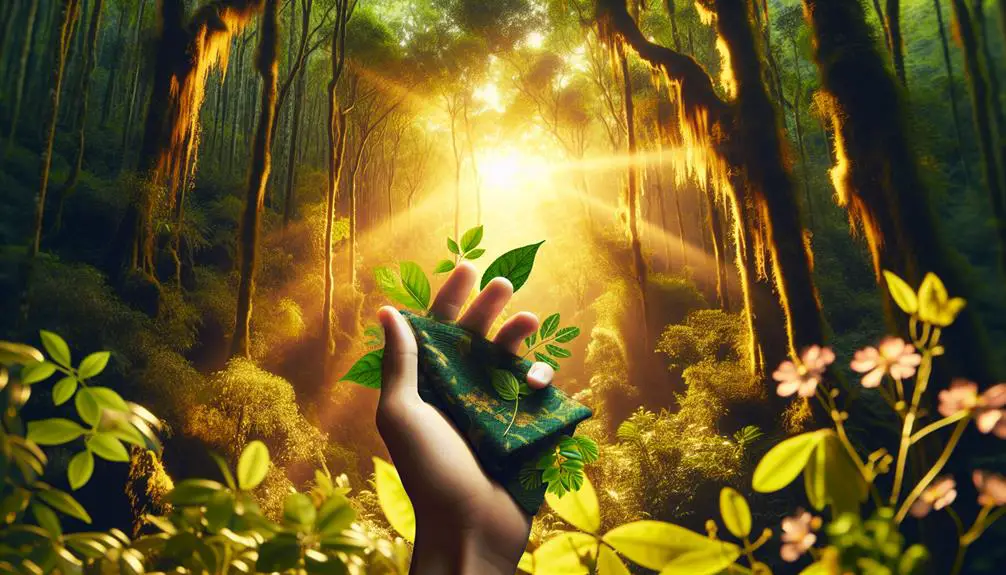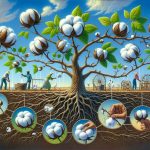Could biodegradable fabrics really be the key to a sustainable future in fashion? You might be curious about how materials like organic cotton, hemp, and bamboo can decompose naturally, reducing landfill waste and returning nutrients to the soil. As consumers become more eco-conscious, the shift toward these sustainable options is gaining traction. However, the journey to a greener wardrobe isn't without its challenges. You'll want to explore how innovative fabric technologies and forward-thinking brands are tackling these obstacles to make biodegradable textiles a viable and impactful choice.
Table of Contents
Key Takeaways
- Biodegradable fabrics decompose naturally, reducing environmental harm and landfill waste.
- Hemp, bamboo, and organic cotton are eco-friendly, offering durability, breathability, and minimal water usage.
- Decomposing biodegradable textiles enriches soil by returning essential nutrients, supporting sustainable agriculture.
- Innovations in plant-based fibers and eco-friendly dye techniques minimize pollution and water consumption.
- Consumer awareness and sustainable fashion brands like Stella McCartney and Patagonia drive the adoption of biodegradable fabrics.
What Are Biodegradable Fabrics?
Biodegradable fabrics are materials that decompose naturally over time without harming the environment. You might wonder how these fabrics differ from synthetic fibers. The key lies in their production methods and their ability to break down.
Biodegradable fabrics, such as organic cotton, wool, and hemp, are produced using natural processes that don't involve harmful chemicals. This makes them a more sustainable choice compared to synthetic fibers like polyester and nylon, which are derived from petroleum and can take hundreds of years to decompose.
Understanding the distinction between biodegradable and synthetic fibers is essential for anyone looking to make more eco-friendly choices. When you're shopping for textiles, keep an eye on the labels and materials used. Consumer awareness is growing, and many brands are now highlighting the biodegradable nature of their products.
By choosing biodegradable fabrics, you're not only reducing your carbon footprint but also supporting sustainable production methods. Educating yourself about these materials empowers you to make better decisions. Remember, every small choice you make—like opting for biodegradable over synthetic—contributes to a healthier planet.
Benefits of Biodegradable Textiles
By choosing biodegradable textiles, you not only make an eco-friendly choice but also enjoy numerous benefits that go beyond environmental impact. One of the most compelling advantages is soil regeneration. When biodegradable fabrics decompose, they return essential nutrients to the earth, enriching the soil and promoting healthier ecosystems. This isn't just a win for the environment; it's a step toward creating more sustainable agriculture and reducing the need for chemical fertilizers.
Incorporating biodegradable textiles into your wardrobe also aligns you with the principles of sustainable fashion. Unlike conventional fabrics that linger in landfills for decades, biodegradable options break down naturally, minimizing waste and pollution. This helps you contribute to a more sustainable and ethical fashion industry, encouraging brands to adopt greener practices.
Moreover, biodegradable textiles play a significant role in the circular economy. Through textile recycling, these fabrics can be transformed into new products, reducing resource consumption and promoting efficiency. This cyclical approach ensures that materials are continuously reused, lowering the overall environmental footprint.
Types of Biodegradable Fabrics
Exploring the various types of biodegradable fabrics, you'll discover a world of eco-friendly materials that can transform your wardrobe and reduce your environmental impact. Hemp textiles, bamboo clothing, corn fibers, and soybean fabrics are among the most innovative and sustainable options available today.
Hemp textiles are incredibly durable and have natural antibacterial properties. They're also highly breathable and can be grown with minimal water and pesticides, making them an excellent choice for sustainable fashion. Bamboo clothing is another fantastic option. It's soft, moisture-wicking, and highly renewable, as bamboo grows rapidly without the need for chemical fertilizers.
Corn fibers, derived from polylactic acid (PLA), offer a versatile and biodegradable option for clothing and accessories. These fibers are lightweight and can be blended with other materials to enhance their properties. Soybean fabrics, often referred to as "vegetable cashmere," are smooth, luxurious, and biodegradable. They provide excellent moisture absorption and are derived from the byproducts of soybean oil production.
| Fabric Type | Key Features | Environmental Impact |
|---|---|---|
| Hemp Textiles | Durable, antibacterial, breathable | Low water usage, minimal pesticides |
| Bamboo Clothing | Soft, moisture-wicking, renewable | Rapid growth, no chemical fertilizers needed |
| Corn Fibers | Lightweight, versatile, biodegradable | Derived from renewable resources |
| Soybean Fabrics | Smooth, luxurious, moisture-absorbing | Utilizes byproducts of soybean oil production |
Natural Fibers
Natural fibers, like cotton, wool, and linen, offer a sustainable and biodegradable alternative to synthetic fabrics, making them an essential part of any eco-friendly wardrobe. By choosing these materials, you're supporting a more sustainable fashion industry and reducing your environmental footprint.
Consider these key benefits of natural fibers:
- Eco-Friendly Production:
Organic cotton and hemp clothing are grown without harmful pesticides and chemicals, promoting soil health and biodiversity. This makes them a healthier choice for both the planet and your skin.
- Durability and Comfort:
The linen industry has long been praised for producing fabrics that are both durable and breathable. Linen's natural fibers become softer with each wash, providing lasting comfort and reducing the need for frequent replacements.
- Versatility:
Bamboo textiles are incredibly versatile, offering a silky texture that's naturally hypoallergenic and moisture-wicking. These properties make bamboo a fantastic option for various types of clothing, from everyday wear to activewear.
Innovations in Fabric Technology
You're about to explore some groundbreaking innovations in fabric technology.
You'll discover how advancements in plant-based fibers and eco-friendly dye techniques are transforming the textile industry.
These developments not only reduce environmental impact but also offer sustainable alternatives for everyday fabrics.
Plant-Based Fiber Advances
In recent years, breakthroughs in plant-based fiber technology have transformed the landscape of biodegradable fabrics. You're witnessing an era where fiber alternatives and sustainable farming practices are becoming the backbone of textile innovation. These advances not only support a circular economy but also empower you to make eco-friendly choices that don't compromise on quality or style.
Here are three exciting developments in plant-based fiber technology:
- Bamboo Fiber: Bamboo is rapidly emerging as a top contender due to its fast growth and minimal need for pesticides, making it an excellent sustainable farming choice. Its fibers are soft, durable, and naturally antibacterial.
- Hemp Fiber: Hemp is another remarkable fiber alternative. It requires less water than cotton and enriches the soil it grows in. Hemp fabric is strong, breathable, and highly resistant to mold and UV light.
- Banana Fiber: Derived from banana plant stems, this fiber is biodegradable and requires minimal processing. It's ideal for creating strong, lightweight textiles perfect for a variety of applications.
Eco-Friendly Dye Techniques
Embracing eco-conscious dye techniques, you can enjoy vibrant and durable colors without harming the environment. One of the most innovative methods is water-efficient printing. This technique reduces water consumption drastically, making it an environmentally conscious choice. By opting for sustainable pigments, you guarantee that the colors are derived from natural sources, minimizing ecological impact.
Non-hazardous coloring is another pivotal aspect of eco-friendly dyeing. Traditional dyes often contain harmful chemicals, but non-hazardous alternatives provide a safer option for both producers and consumers. These methods not only protect the environment but also promote healthier working conditions.
Here's a quick comparison of various eco-friendly dye techniques:
| Technique | Benefits | Key Feature |
|---|---|---|
| Water-efficient Printing | Reduces water usage | Uses minimal water |
| Sustainable Pigments | Minimizes ecological impact | Derived from natural sources |
| Non-Hazardous Coloring | Safe for producers and consumers | Free from harmful chemicals |
| Eco-Conscious Methods | Promotes sustainability | Focuses on environmental health |
| Natural Dyeing | Biodegradable | Uses plant-based dyes |
Environmental Impact
Biodegradable fabrics greatly reduce waste by breaking down naturally and lessening the burden on landfills. When you choose these fabrics, you're actively participating in recycling initiatives that lower the carbon footprint of the textile industry. Unlike synthetic materials, biodegradable options decompose, returning nutrients to the soil without releasing harmful chemicals. This makes them a pivotal component in sustainable practices.
You'll find that biodegradable fabrics also excel in water conservation. Traditional textile production is notoriously water-intensive, but sustainable materials often require less water during their lifecycle. By opting for these fabrics, you're contributing to a more responsible use of one of our most precious resources.
Consider these benefits:
- Lower Landfill Impact: Biodegradable fabrics decompose naturally, reducing the volume of waste in landfills.
- Less Pollution: These materials break down without releasing toxins, leading to cleaner air and water.
- Resource Efficiency: They often demand less water and energy, aligning with sustainable practices.
Challenges and Solutions
While biodegradable textiles offer numerous environmental benefits, they also come with distinct challenges that need addressing to maximize their potential. One significant hurdle is the lack of robust recycling initiatives. Although these fabrics break down naturally, integrating them into a circular economy demands a thorough recycling infrastructure. You need to guarantee that biodegradable textiles don't end up in landfills where they mightn't decompose efficiently due to suboptimal conditions.
Another challenge is consumer education. Many individuals are still unaware of the benefits and proper disposal methods for biodegradable fabrics. You can't expect widespread adoption of sustainable practices without informing consumers about the importance of these materials and how they contribute to environmental sustainability. Educational campaigns and clear labeling can guide consumers in making eco-friendly choices.
Moreover, the production of biodegradable textiles often requires advanced technology and higher costs, which can be a barrier for widespread implementation. To overcome this, you should focus on research and development to make these fabrics more affordable and accessible.
Brands Leading the Way
Several pioneering brands are setting new standards in the sustainable fashion industry by prioritizing biodegradable fabrics. These brands aren't only embracing sustainable practices but also ensuring ethical production—catering to the growing number of eco-conscious consumers who value brand transparency.
Let's highlight three standout brands leading this green revolution:
- Stella McCartney: Known for her commitment to sustainability, Stella McCartney uses innovative materials like biodegradable faux leather and organic cotton. Her brand's transparency and dedication to ethical production make it a favorite among eco-conscious consumers.
- Patagonia: This brand has long championed environmental causes. Patagonia utilizes biodegradable fabrics, such as recycled wool and organic cotton, and maintains a transparent supply chain. Their sustainable practices resonate with consumers who prioritize ethical production.
- Eileen Fisher: With a focus on simplicity and sustainability, Eileen Fisher has integrated biodegradable fabrics into their collections. The brand's “Renew” and “Waste No More” programs are exemplary of its commitment to a circular fashion economy and brand transparency.
Future of Sustainable Fashion
As we look ahead, the future of sustainable fashion promises even more innovative solutions and groundbreaking materials that will redefine the industry. By embracing the principles of a circular economy, you'll see a shift towards products designed with their entire lifecycle in mind. This means less waste and more recycling, ensuring that fashion pieces don't just end up in landfills.
Ethical production will also become a cornerstone, as brands prioritize fair labor practices and environmentally-friendly processes.
You'll find that slow fashion will gain traction, encouraging consumers to buy less but choose better. This approach not only minimizes waste but also fosters a deeper appreciation for craftsmanship. Sustainable materials, such as biodegradable fabrics, will be at the forefront of this movement, offering alternatives that are both stylish and environmentally conscious.
As a consumer, you'll have the power to influence this change. By supporting brands that align with these values, you're contributing to a more sustainable and ethical fashion industry.
The future of sustainable fashion isn't just a trend—it's a necessary evolution that promises to protect our planet and promote a more equitable industry. Embrace it, and be a part of the transformation.
Frequently Asked Questions
How Do Biodegradable Fabrics Compare in Cost to Traditional Fabrics?
When you consider cost comparison, biodegradable fabrics can be more expensive upfront than traditional fabrics. However, their long-term environmental impact is notably lower, making them a wise investment for those prioritizing sustainability and ecological responsibility.
Are There Any Health Benefits Associated With Wearing Biodegradable Fabrics?
Imagine unparalleled luxury for your skin—biodegradable fabrics offer extraordinary skin benefits and comfort advantages. You'll experience fewer irritations and supreme softness, making every wear feel like a spa treatment. Elevate your wardrobe with these healthful choices!
What Care Instructions Are Recommended for Biodegradable Garments?
For biodegradable garments, follow washing guidelines like gentle cycles and cold water. Storage tips include keeping them in cool, dry places. Reduce environmental impact by using eco-friendly detergents. For disposal methods, compost or recycle appropriately.
Can Biodegradable Fabrics Be Used in Industrial Applications?
You might wonder if biodegradable fabrics can be used in industrial applications. Surprisingly, they can, offering durability and a reduced environmental impact. By choosing these materials, you're advancing innovation and sustainability in industrial contexts.
How Do Biodegradable Fabrics Fare in Terms of Durability and Longevity?
You'll find that biodegradable fabrics balance environmental impact with wearability. While they may not last as long as traditional materials, their biodegradability and sustainability make them a smart choice for reducing waste without sacrificing comfort.
- Tetron Fabric for Marine Applications: Durability and Use Cases - June 18, 2025
- Tetron Fabric for Outdoor Furniture: Weather Resistance and Care - June 18, 2025
- Tetron Fabric for Wall Coverings: Style and Application Tips - June 18, 2025




